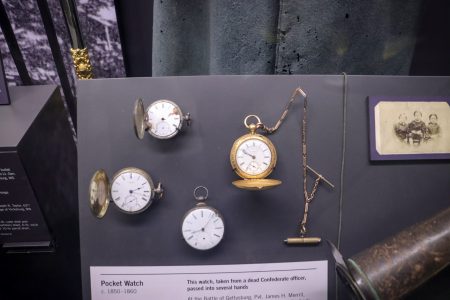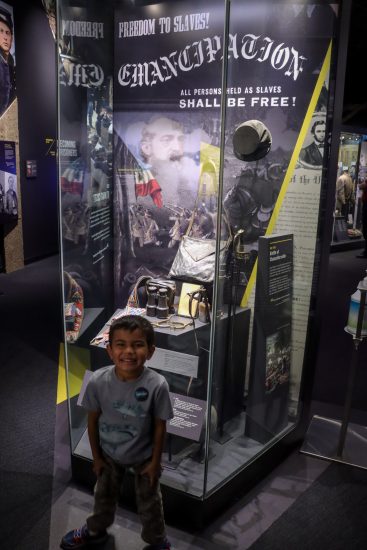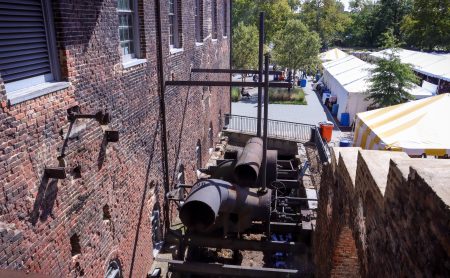
I’ve had the opportunity to go to quite a few history museums, and one of my favorites was the Museum of the Confederacy in Richmond, VA (which I wrote a little about here). In 2019 it shut down – or rather merged with another institution to form the American Civil War Museum at Historic Tredegar. A few weeks ago I had the chance to go with my family and see whether it lived up to the standard of the Museum of the Confederacy.
Let’s start with some of the things I liked. The building is impressive, and it is built among the ruins of the Tredegar Iron Works, a historic Civil War site in its own right. Some parts of this were quite interesting, and I wish there had been more interpretation of the structures. Going through the exhibits, I was surprised that it seemed smaller than I expected. The downstairs was what seemed to be their permanent gallery on the war, and upstairs there were some rather unsubstantial temporary exhibits. It seems that part of the upstairs may still be under construction, so my impression may change once that opens.
The displays were in certain ways well designed, certainly flashier than the previous incarnation. There were plenty of video screens and interactive displays. While those aren’t of much interest to me at this particular museum, I’m sure a lot of people appreciate them. They did have a lot of artifacts on display, but I did notice some huge walls that just had a graphic or image on them, when it seemed like it could have been used to display a lot more artifacts.

In terms of their actual interpretation of the Civil War – the words on the walls, I don’t have a lot of complaints. Admittedly I didn’t get a chance to read them that closely, as my focus was more on getting my children engaged with the museum. From what I saw they were pretty middle of the road, asking questions designed to engage critical thinking rather than explicitly telling you what to think. One that stood out to me was in a special exhibit on money, which answered the question, “What is inflation?” by saying:
Inflation is like shoveling coal into a steam engine. If you don’t put in enough fuel (deflation) the engine won’t have enough power and will die … Put in too much, you can watch the engine explode (a ‘panic’). Put in just the right amount, and you can have steady power (a thriving economy).
While I know a lot of economists and politicians would agree with that, many others (including me) certainly do not, and would see it as pushing a harmful falsehood. It’s a very controversial statement to put as fact on the wall of the museum.
What I liked about the original Museum of the Confederacy wasn’t some neo-Confederate interpretation (I’ve been to a lot more pro-Confederate museums), it wasn’t based on it being huge, and it certainly wasn’t it’s impressive technological displays (it was admittedly a bit dated). It was the artifacts. The institution was over a hundred years old, and had amassed a really amazing collection. It became the place where the families of the Confederates generals gave the relics from their relatives so their memory could be preserved. For a Civil War buff, this made it an amazing experience. The exhibits weren’t huge, but it seemed like every artifact had a story of historic significance that you’d read about a hundred times. Stuart’s plumed hat. The overcoat in which Jackson was shot. The hat Armistead carried on his sword in Pickett’s charge. According to my likely exaggerated memory, nothing there was just a generic uniform, rifle or equipment of a rebel soldier, everything had some special significance in Civil War history.
The good news is that the new American Civil War Center has (at least generally) that same collection. There were a few impressive artifacts that I remember that are not on display – Robert E. Lee’s tent and the battle torn flag of the 26th NC. Perhaps there’s some other reason they aren’t on display, but if they’ve chosen to just keep them in storage, that’s a travesty. Despite that, there were a lot of the amazing artifacts I remembered on display. But unfortunately, it seemed like they were ashamed of them.

The famous artifacts on display are often so hard to identify that they are effectively hidden. The items are labeled with a small plaque in the bottom corner of the case. Often the other text and graphics in the display give no hint as to the importance of what you are looking at. Over and over again I found myself bending over and trying to make out the labels to understand what I was looking at. One general’s coat, Dorsey Pender’s if I remember correctly, was right next to a plaque about an unrelated Union naval officer, and if you didn’t look at that little legend you wouldn’t know it wasn’t his. Jackson’s kepi was in a display case with no picture of the general and no special interpretation. If you want to see the hat of one of the most famous generals in American history, you better hope you read those little signs carefully. They had a display of four pocket watches, and you had to look elsewhere in the case to see that one was the pocket watch of Major General Harry Heth, and the others were of nondescript soldiers.1 This was not true of all of them, the case of Robert E. Lee’s artifacts, for example, was better marked. But I noticed it over and over again – so many times that it had to be an intentional choice. It seemed like they were intentionally trying to hide some of the most famous and unique artifacts in their collection.

Why would they do this? Part of the reason for the new museum was to interpret the Civil War from a wider range of perspectives – not just Confederate soldiers, but Federals, slaves and women.2 I don’t inherently have a problem with this. If they had, for example, simply tripled the size of the museum and brought in a bunch of amazing Northern artifacts, that would have been great. But that wasn’t really possible. Historical artifacts at the level of what they had for the Confederacy would be very expensive and probably simply impossible to obtain. You can’t just scrounge up Grant’s sword, Lincoln’s hat, Sheridan’s sword and Meade’s desk on whim. If those artifacts exist, they are probably at an institution very much interested in keeping them. The impression I got from the American Civil War Museum was that they hadn’t added all that much to the Museum of the Confederacy’s collection, especially not artifacts at the same level of prominence. What were they to do? The whole point of the museum was to discuss the war from different perspectives, but they were stuck with all these Confederate artifacts? It seems the choice they made was to minimize, downplay and even hide those artifacts, to avoid being, or being seen, as a Lost Cause mecca. Those artifacts are what makes this museum special, but focusing on interpreting them doesn’t fit their agenda.
1. I may have a few of these details incorrect, as I only took a few photos in the museum, but I think this is a fair characterization of how they chose to display their collection.
2. Women were certainly important in the entire story of the Civil War, but it seems quite inappropriate that the woman is in the foreground of The American Civil War Museum’s logo, in front of the slave and the non-descript soldier.





I shared your review through the “contact us” button for the museum, subject “exhibits” saying I agreed with the review and that it expressed some of my concerns with the exhibits.